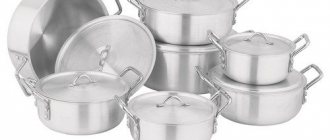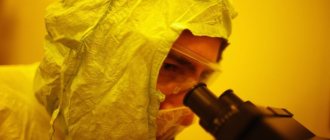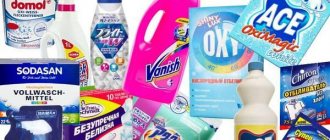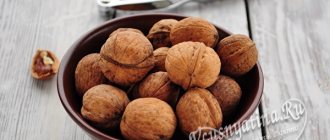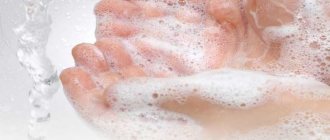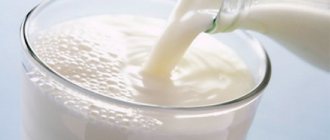Washing is an integral part of our daily life. Usually we don’t even think about what a detergent consists of. And when purchasing, we focus only on the popularity of the brand and the inscriptions on the packaging. But in vain, because the powders can contain things that can make you itch, blush and sneeze. Manufacturers add harmful and dangerous components to many laundry products that can cause skin irritation, allergies and other problems. So, let's look inside the packaging of the powder and find out what zeolites do in washing powder, the harm and benefits of surfactants, phosphates and phosphonates.
Zeolites in washing powder: harm and benefit
Zeolites are considered one of the safe additives in detergents. The use of zeolites in washing powders began about 25 years ago in order to replace phosphates that are harmful to humans. They are minerals with sorbent properties. And, like activated carbon, they “pull” dirt out of clothes. In nature, there are more than 40 types of zeolites, formed under certain conditions from volcanic or bottom sea rocks. Natural zeolites are absolutely safe and are even added to eco-powders; they are listed under the word zeolith in the composition. Let's look at the benefits and harms of zeolites.
Benefits of zeolites
Children's phosphate-free powders
You should approach washing children's clothes even more carefully. It is not enough to remove phosphorus from the composition; the product must be absolutely natural and non-allergenic.
Based on testing results, Roskontrol defines such brands as “Ushastiy Nyan”, “Aistenok” as toxic and does not recommend them for washing children’s underwear.
After a detailed analysis of the reviews and composition of washing powders for children and newborns, we can highlight the list organic natural :
- Pure Water. Contains coconut oil sodium salts, soda, percarbonate, citrate and sodium silicate. The most effective natural laundry product that cleans even greasy stains. It has an interesting texture of large flakes.
- "Our mother". Contains tallowate, sodium cocoate and palmitate, water, titanium dioxide, glycerin. It looks like soap shavings, rinses out clothes well, and does not wash out old stains.
- Garden Kids. Made from 30% baby soap, 60% soda, sodium citrate and silver. Like any natural product, Garden Kids will not cope with traces of fruit or chocolate, but is absolutely safe for the baby’s delicate skin.
Zeolites and phosphates
Phosphates (or sodium tripolyphosphate) are synthetic detergents and have a very adverse effect on the human body. They are a compound of sodium, phosphoric acid, potassium or calcium. The phosphate content in detergent can reach 60%. And the more there is, the worse it is for us. In some countries around the world this chemical is completely banned. Russia has more lenient laws in this regard, and powder manufacturers generously flavor their products with this poison. This is because phosphates have good cleaning ability. And this is the main condition for the powder and large volumes of its sales. But the safety of the detergent is also important. And here’s how these synthetic additives can harm us:
- increase the toxicity of surfactants;
- they are very poorly washed out of clothing and penetrate through it into the skin and blood, disrupting the functioning of cells;
- Harm the environment by getting into rivers through sewage treatment plants and becoming a fertilizer for algae, thereby stimulating their growth. This can cause fish and other marine life to die in water bodies;
- upon contact with the skin, they make it dry and vulnerable to the external environment. As a result, the protective functions of the dermis are reduced, and the risk of dust, dirt, bacteria and viruses entering it increases;
- capable of lowering hemoglobin and thinning the blood;
- A negative effect on the blood can result in problems with the liver, kidneys, muscles and bones.
Based on the above, we conclude that we do not need powders with phosphates in the house. They are harmful, toxic and extremely dangerous.
The environmental literacy of the population is constantly increasing. Quite a lot of people know about the dangers of phosphates and do not buy detergents containing them. Manufacturers also do not stand still and try to minimize harm by replacing phosphates with phosphonates, claiming that they are harmless. But this is not entirely true.
What is their harm to humans?
Phosphates can harm human health. First of all, they pose a danger to the skin, as they disrupt its natural acid-base balance.
This causes:
- dermatitis,
- hives,
- itching,
- rashes and inflammatory reactions.
In addition, regular contact with phosphates poses the following problems:
- Decreased hemoglobin levels in the blood.
- Disorders of the liver and kidneys.
- Increased risk of developing cancer.
- General intoxication of the body.
- Metabolic failure.
Phosphates are especially dangerous for children. Therefore, it is not recommended to use such powders for washing children’s clothes.
It is not for nothing that European countries introduced strict restrictions on the use of phosphates in household chemicals back in 2010.
Phosphonates in washing powders
Phosphonates are phosphorus compounds with the addition of carbon. They are classified as organophosphorus - they are designed to soften water and remove dirt. The industrial name for phosphonates is tetrasodium etidronate. This is the marking you should look for in a soap, detergent or powder. Just like zeolites, several dozen types of phosphonates have been created. Some are safe, while others are poisonous and are often used in pesticides. Under certain conditions, phosphonates can turn into phosphates and then become dangerous. The advantage of these esters is that they are added to the powder much less than phosphates. Therefore, they are less dangerous and also harm the environment less than phosphates.
Rating of phosphate-free powders
Almost all brands have lines of phosphate-free laundry detergents, but this does not mean they are safe. Concentrated, odorless and surfactant-free products are produced by Japan, South Korea, Austrian and German manufacturers, they are certified and tested.
| Name | Compound | Advantages | Flaws | Price |
| Garden eco-friendly universal | 30% natural soap, 60% soda, citric acid | Does not contain chemicals, suitable for allergy sufferers, washing baby clothes. Rinses well, made in Russia | Does not remove old stains, not suitable for dark clothes | 1350 g - 286 rub. |
| "HAAH" | 5–15% anionic and <5% nonionic surfactants, polycarboxylates, oxygen stain remover, soap, enzymes, anti-Calc agents, cold wash activator, optical brightener, perfume composition | Universal, washes stains well, which makes it different from other eco-friendly products. Washable in cold water | A pungent odor remains on the laundry. Economical: 3 kg - 83 washes | 3 kg - 662 rub. |
| "Cleantown Professional" | Natural soap - 30-33%, soda - 62-65%, citric acid - 0.1-0.25%, water - 1.2-7% | No odor, no synthetic compounds, safe for allergy sufferers | Makes laundry hard and requires ironing or conditioner | 10 kg—2200 rub. |
| Chu Chu Baby Pigeon | Soap - 54%, surfactant - 3%; polyoxyethylene alkyl ether, alkaline reagent, carbonate, water softener | Efficient and economical to use. Japanese quality | Not always on sale | 1.6 kg - 600 rub. |
The table deliberately does not include brands such as Persil and Ariel. Apart from the inclusion of phosphonates and zeolites, they are no different from ordinary household chemicals.
What is a surfactant in washing powder
The main components of any detergent, be it powder or dishwashing gel, are surfactants, abbreviated as surfactants. They belong to synthetic chemical compounds and are responsible for softening water and removing contaminants. Research on these chemical additives took place back in the 60s of the 20th century. Scientists have found that they are extremely aggressive and can harm human health, for example:
- disrupt the functioning of the immune system and metabolic processes in the human body;
- provoke allergies;
- when accumulated in the body in large quantities, it affects the cells of the liver, brain, kidneys and lungs;
- do not rinse out of clothes and through it penetrate into us and cause harm. The worst way to remove surfactants is from cotton, wool and half-woolen products, remaining in them for a long time and in contact with the skin;
- a dangerously high content of these substances remains on clothing for 4 days, this time is enough to cause poisoning of the body;
- harm water bodies, causing them to become overgrown with algae, which leads to river pollution and deterioration in the quality of drinking water.
Surfactant powders should not contain more than 7%, and in many European countries they are prohibited by law and are not even added to car detergents.
Chemical properties
Primary phosphonates are moderately strong acids (for example, for n-ClC6H4P(O)(OC4H9)OH pKa = 1.7) and form amine salts; secondary phosphonates form adducts with Lewis acids (for example, with boron halides).
Primary phosphonates, when heated, disproportionate to form polyphosphates; secondary dialkylphosphonates, when heated above 150°C, decompose to form primary phosphonates and alkenes:
RP(O)(CH2CH2R1)2 \to RP(O)(OH)CH2CH2R1 + R1CH=CH2
When interacting with phosphorus pentachloride, both primary and secondary phosphonates form phosphonic acid chlorides:
RP(O)R12 + PCl5 \to RP(O)R1Cl + R1Cl + POCl3
Zeolites in washing powder, harm and benefit - summing up
The scientific community has proven that 100 grams of surfactants can kill an adult horse in 24 hours. Phosphates, combining with surfactants, remain in the fabric after washing, penetrate the skin and accumulate in the body. Who knows what health problems this influence can lead to; doctors often fail to find out the causes of many chronic and sudden diseases in humans. A good powder should not contain synthetic flavors, phosphates, chlorine, ammonia, sulfates, boron, phosphonates, or surfactants. Therefore, you need to carefully choose your laundry detergent - this way you will preserve the health of yourself and your family.
Thanks for sharing with your friends!
- 2
- 1
What are they and why are they added?
Phosphates are represented by compounds of mineral phosphorus, oxygen and hydrogen. These substances belong to the class of salts that are formed during the chemical reaction of phosphoric acid with other components.
Phosphates can be powdered or liquid. They are added to laundry detergents to increase cleaning power.
The main effects that can be achieved by including them in the powder composition:
hard water becomes soft;- Surfactants penetrate fibers more easily;
- contaminants washed away from the surface of things no longer settle on them;
- Mineral deposits are better washed out of fabric fibers;
- stains with a fatty component are washed off well;
- The quality of washing is improved by breaking large particles of dirt into small ones.
Phosphates can be found not only in powders, but also in food products, where they act as stabilizers and acidity regulators. However, household chemicals use unrefined compounds that contain impurities of harmful components.
An excerpt characterizing Phosphonates
He also managed to distinguish himself in the Finnish War. He picked up a fragment of a grenade that killed the adjutant next to the commander-in-chief and presented this fragment to the commander. Just like after Austerlitz, he told everyone so long and persistently about this event that everyone also believed that it had to be done, and Berg received two awards for the Finnish War. In 1919 he was a captain of the guard with orders and occupied some special advantageous places in St. Petersburg. Although some freethinkers smiled when they were told about Berg’s merits, one could not help but agree that Berg was a serviceable, brave officer, in excellent standing with his superiors, and a moral young man with a brilliant career ahead and even a strong position in society. Four years ago, having met a German comrade in the stalls of a Moscow theater, Berg pointed him to Vera Rostova and said in German: “Das soll mein Weib werden,” [She should be my wife], and from that moment he decided to marry her. Now, in St. Petersburg, having realized the position of the Rostovs and his own, he decided that the time had come and made an offer. Berg's proposal was accepted at first with unflattering bewilderment. At first it seemed strange that the son of a dark Livonian nobleman was proposing to Countess Rostova; but the main quality of Berg’s character was such naive and good-natured egoism that the Rostovs involuntarily thought that this would be good, if he himself was so firmly convinced that it was good and even very good. Moreover, the Rostovs’ affairs were very upset, which the groom could not help but know, and most importantly, Vera was 24 years old, she traveled everywhere, and, despite the fact that she was undoubtedly good and reasonable, no one had ever proposed to her . Consent was given. “You see,” Berg said to his comrade, whom he called friend only because he knew that all people have friends. “You see, I figured it all out, and I wouldn’t have gotten married if I hadn’t thought it all through, and for some reason it would have been inconvenient.” But now, on the contrary, my father and mother are now provided for, I arranged this rent for them in the Baltic region, and I can live in St. Petersburg with my salary, with her condition and with my neatness. You can live well. I’m not marrying for money, I think it’s ignoble, but it’s necessary for the wife to bring hers, and the husband to bring his. I have a service - it has connections and small funds. This means something nowadays, doesn’t it? And most importantly, she is a wonderful, respectable girl and loves me...
Recommendations for use
If you are not ready to completely give up harmful household chemicals, minimize their negative effects on the body.
Be sure to wear protective clothing
Protect yourself by following these recommendations:
- after washing with bleach or an aggressive stain remover, rinse any remaining toxic substances at least 6 times in hot water (if the fabric allows it);
- Use bleaches when absolutely necessary, choose products without fragrances or fragrances;
- instead of using refreshing aerosols, ventilate the apartment more often;
- always clean your apartment wearing rubber gloves and a bandage, protect your skin from household chemicals (when using caustic cleaners, additionally protect your eyes);
- Clean in a ventilated area; during the cold season, try to ventilate the apartment for at least 15 minutes. after completion of all manipulations;
- buy products that contain no more than 5% surfactants and phosphates; the products must be certified, without a pungent odor, hermetically sealed;
- more does not mean better: do not get carried away with large dosages of disinfectants;
- do not mix the compositions of different detergents and cleaning products;
- minimize the use of polishes, otherwise choose products based on natural wax;
- use aggressive chemicals as rarely as possible, alternating them with delicate compounds or folk remedies.
Train yourself and your household to wash dishes immediately after eating, and remove fresh dirt before it sticks to the surface with a “death grip.” This will minimize the use of harmful chemicals in everyday life.
What do household chemicals contain?
- Air fresheners. Don't let the advertising fool you. Unpleasant odors do not disappear. Most air fresheners interfere with a person's ability to smell by shutting down your nasal sensory areas using special substances. Common chemicals in air fresheners include formaldehyde (a highly toxic known carcinogen) and phenol (which can cause seizures, coma, and even death).
- Cleaning products with ammonia. Ammonia is found in a variety of household kitchen and bathroom cleaners, glass cleaners and furniture cleaners. If a product contains more than 5% ammonia, it should be labeled as hazardous. Ammonia is a volatile chemical that can damage your eyes, respiratory tract and skin.
- Chlorine bleach is a strong corrosive that can cause damage to the skin, eyes and respiratory tract. NEVER mix bleach with ammonia as the fumes can be lethal.
Carpet and upholstery cleaners typically contain highly toxic substances such as perchlorethylene (a known carcinogen that damages the liver, kidneys and nervous system) and ammonium hydroxide (a harsh product that irritates the eyes, skin and respiratory tract).
Moisturizers typically include lye (which can burn the skin and eyes, esophagus, and stomach if ingested), hydrochloric acid (an eye and skin irritant that damages the kidneys, liver, and digestive tract), or tricholoroethane (an eye and skin irritant and a nervous system depressant). ).
Furniture polishes often contain phenol as well as nitrobenzene, which is an extremely toxic chemical that is easily absorbed through the skin.
Mold and mildew cleaners often contain sodium hypochlorite (an irritant that can cause pulmonary edema) and formaldehyde (a highly toxic, known carcinogen).
Oven cleaner contains lye (sodium hydroxide). Damages skin, irritates respiratory tract
Antibacterial products often contain triclosan, which is absorbed through the skin and has been linked to liver damage. Antibacterial soap may also promote the development of drug-resistant bacteria.
Toilet bowl cleaners may contain hydrochloric acid or hypochlorite bleach, which are strong skin irritants.
Bonus: how to avoid harmful household chemicals
Read the ingredients
The simplest advice, which for some reason many people neglect. Yes, the ingredients are often printed in extremely small print, but take the time to make sure that the products you use in your everyday life are truly safe.
Choose eco-brands
If you have neither the time nor the desire to check bottles of household chemicals every time, turn to eco-brands whose products are safer for both humans and nature.
Unsplash
There are also products with special eco-labels on the packaging (they can be found even in regular supermarkets).
Unsplash
There are other specialized sites that will help you understand the dangers (or lack thereof) of the components of cleaning products: for example, ecogolik.ru, ewg.org, bloggoods.ru.
DIY cleaning products
As you already understand, the vast majority of washing powders, cleaning products, sprays, bleaches and other “useful” household chemicals do much more harm to our health than the expected benefit from them. Thus, some of them contain formaldehyde, a carcinogenic substance that causes cancer.
The cleaning products we use pollute the air in our homes with harmful chemicals. When they come into contact with the skin of the hands, they cause allergies, skin irritation, and splitting of nails.
When choosing household chemicals, first of all, you need to carefully read the label and be guided by the naturalness of the product.
But manufacturers are not very concerned about the environment and consumers, so there is not much to choose from the presented range of products. Therefore, the right decision would be to make cleaning products and detergents with your own hands. I present to your attention good, proven recipes for cleaning products that will help make your home cleaner and safer.
DIY cleaning powder
Through trials and experiments, a very good cleaning powder was obtained that does not contain harmful substances. It can be used for washing dishes in the kitchen, tiles in the bathroom and plumbing.
Ingredients:
- dry mustard powder - 5 tbsp. spoon;
- soda - 7 tbsp. spoon;
- salt - 1 tbsp. spoon;
- citric acid - 1 tbsp. spoon.
Preparation:
- Place all the ingredients in a dry bowl.
- Mix everything very well.
- After this, pour the resulting mass into a box convenient for you and use it for cleaning.
The prepared powder washes kitchen utensils and plumbing fixtures very well. Removes unpleasant odors and most importantly it is harmless and natural.
Home cleaning detergent
In order to thoroughly clean surfaces throughout the house, I recommend a proven detergent; it’s easy for the office to make with your own hands.
Ingredients:
- vinegar - 100 milliliters;
- ammonia - 100 milliliters;
- water - 150 milliliters.
Preparation:
- Carefully pour all the ingredients into a spray bottle and mix.
- Apply a little of the prepared solution to the desired surface and wipe with a cloth.
This product perfectly cleans walls, kitchen surfaces, glass, and tiles.
For those who like to wash their dishes with liquid detergent, we will prepare the following composition:
- laundry soap - 50 grams (regular soap without additives and odors);
- soda - 3 tbsp. spoons;
- coarse kitchen salt - 1 tbsp. spoon;
- hot water - 250 grams.
Preparation:
- Pour the laundry soap with hot water and rinse it off until completely dissolved. We should get soapy water.
- Add soda and kitchen salt, mix everything well and wait until the soda and salt dissolve.
- Strain the resulting mixture and pour it into a spray bottle or a container of dishwashing detergent that is convenient for you.
Vinegar solution
This simple and natural product is great for cleaning.
Preparation:
- We remove the peel from one lemon, fill it in a jar with vinegar - 150 milliliters.
- Close the lid and leave to brew for 12 hours.
- Then add water - 150 milliliters, mix and use.
This product cleans all surfaces well and can be used in a spray bottle.
Essential oils
Essences and essential oils of lavender, orange, lemon, spruce, eucalyptus are excellent air fresheners.
Add a few drops of fragrant oil to the aroma lamp and turn it on for half an hour. You will be guaranteed a wonderful aroma in the house and a good mood.
What are phosphates replaced with?
Replacing chemicals with gentler substances has a positive effect on health, but is more expensive.
Phosphonates are esters. They are considered a safe replacement for harsh chemicals. These substances are less harmful to the environment, but their effect is several times weaker than phosphorus salts. The use of ethers is much more expensive. They have allergenic and carcinogenic properties. It is believed that products containing phosphonates are not dangerous to humans. Zeolites threaten the environment and humans. Their use increases the cost of the product by an average of 30%. Due to their high molecular weight, these chemicals of the silicate group cause breakdowns in the washing machine and increase the load on the cleaning facilities, which accelerates their wear.
In EU countries, thanks to strict legislative measures, penalties against manufacturers and environmental education of the population, attempts are being made to switch to natural detergents. Natural ingredients that replace phosphates include palm soap, soap nuts, and fatty acid salts. They are expensive and degrade the quality of washing, but they have no negative impact on nature and humans.
